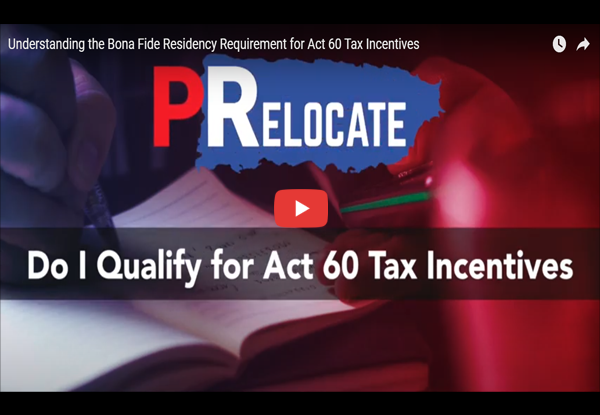Earthquakes Declared a Major Disaster – Effect on Puerto Rico Presence – Updated March 2, 2020
- Posted: January 21, 2020
- Posted by: Travis Lynk
- Last Reviewed: May 21, 2021

Earthquakes Declared a Major Disaster – Effect on Puerto Rico Presence – Scroll Down for Update on March 2, 2020
Please note the below article is based on our analysis, historical precedent, and conversations with advisors. There is currently no consensus on the specific effect on the presence test and if / which 14+ days will count towards bona fide presence. We strongly suggest you discuss the below analysis with your tax advisor and reach your own conclusions.
The Puerto Rico Earthquakes have been declared a national disaster by President Trump, and those Act 60 [formerly Act 20 and 22] decree holders seeking to qualify for bona fide residence in 2020 should automatically receive at least 14 days of presence in Puerto Rico based on our analysis of similar historical events
If you are one of those decree holders who always cut it close to the 183 days, now could be the time to do some off-island travel without eating into your planned 2020 travel days.
For those Act 60 (formerly Act 20 and 22) decree holders seeking to qualify as bona fide residents of Puerto Rico for 2020, it is important to understand that per the IRS rules (see IRS Publication 570: Current Tax Guide for Individuals with Income from U.S. Possessions), you must be present in the relevant possession [Puerto Rico] for at least 183 days during the tax year.
The IRS Publication 570 (updated February 21, 2020) specifically states that you are considered to be present in the relevant possession [Puerto Rico] on any of the following days: “Any day you are outside the relevant possession because you leave or are unable to return to the relevant possession during a 14-day period within which a major disaster occurs in the relevant possession for which a Federal Emergency Management Agency (‘FEMA’) notice of a federal declaration of a major disaster is issued in the Federal Register.”
For those in Puerto Rico who are living in the San Juan metro area or another area that is not within the designated FEMA impact area, it is important to note that the IRS language specifically states that the major disaster must only occur “in the relevant possession” and not that it must occur in the specific town, city, county, etc. of the relevant possession where FEMA aid is being provided. As written and based on our analysis, if you are anywhere in the relevant possession [Puerto Rico], the 14-day-period rule applies to you.
Now let’s take a look back to see how this 14-day-period rule was applied for Hurricane Irma and Hurricane Maria. FEMA issued a notice of a federal declaration of a major disaster in the Federal Register on September 7, 2017, for Hurricane Irma (disaster #4335) and on September 20, 2017, for Hurricane Maria (disaster #4339). IRS Publication 570 states that the original 14-day period (which was extended to 268 days in total) began on September 6, 2017 – one day prior to the FEMA notice of a federal declaration in the Federal Register – and ended on May 31, 2018.
Applying the exact same procedure to the current series of earthquakes (disaster #4473), the initial 14-day period for automatic days of presence in Puerto Rico would begin on January 15, 2020, one day prior to the day the official major disaster declaration, and would end on January 29, 2020
The series of earthquakes that began on December 28, 2019, is listed by FEMA as having an incident period of December 28, 2019 and continuing. If we look back to Hurricane Irma and Hurrican Maria, we see that the incident period listed for Hurricane Irma is September 5, 2017, to September 7, 2017, and for Hurricane Maria, it is September 17, 2017, to November 15, 2017. The significance of this is that since the incident period for the Puerto Rico Earthquakes is still listed as continuing and the IRS language states a “14-day period within which a major disaster occurs in the relevant possession,” this implies that the 14-day period could be extended for at least 14 days after the end of the incident period listed by FEMA for the Puerto Rico Earthquakes. Therefore, this could mean that the effective period for counting days outside of Puerto Rico with respect to the Puerto Rico Earthquakes would very likely start on December 28, 2019 (the start date of the incident) and be extended to at least 14 days following the termination of the incident period listed by FEMA.
We will need to stay tuned and look for IRS guidance on the complete window of time that will be listed for days of automatic presence in Puerto Rico. The notice should look just like Notice 2017-56 for Hurricane Maria, which was issued on October 2, 2017, and initially extended the 14-day period to 117 days. The IRS publishes these notices on its online bulletin page here. Please note the official IRS guidance on the period and days has not been provided to date.
Conservative Conclusion: If your goal is to just hit the 183 days in Puerto Rico, then the 14-day period from January 15 through January 29, 2020, is a window where you can travel and be outside of Puerto Rico and still have those days count toward the required 183 days of presence to maintain your bona fide residence status. This is a conservative approach to the counting of automatic Puerto Rico presence days and follows the exact same start period methodology for counting days as was applied by the IRS for Hurricanes Irma and Maria.
Aggressive Conclusion: It is likely that the 14-day period will actually be a lot longer and that the period for automatic presence days in Puerto Rico will start on December 29, 2019 (the day immediately following the first earthquake) and will be extended to at least 14 days after the termination of the incident period as listed by FEMA, which, as of January 21, 2020, is still listed as December 28, 2019, and continuing, according the official FEMA Puerto Rico Earthquakes page (disaster #4773).
UPDATE AS OF MARCH 2, 2020
As of March 2, 2020, the major disaster (series of earthquakes) that began on December 28, 2019, is now listed by FEMA as having an incident period of December 28, 2019 through February 4, 2020. Click here to view the incident period on the FEMA website.
Updated Conservative Conclusion: The official incident period is now 39 days, from December 28, 2019 through February 4, 2020. If we apply the rule listed in Publication 570 “You are considered to be present in the relevant territory for any 14-day period within which a major disaster occurs in the relevant territory” then this means that you can apply the 14-day period against any days within the 38 days that comprise the incident period for the disaster. Example: if you travelled to Florida for 10 days (January 10-20, 2020) then you could apply the 14-day period against these Florida days and you would count all 10 as days in Puerto Rico.
Disclaimer: Neither PRelocate, LLC, nor any of its affiliates (together “PRelocate”) are law firms, and this is not legal advice. You should use common sense and rely on your own legal counsel for a formal legal opinion on Puerto Rico’s tax incentives, maintaining bona fide residence in Puerto Rico, and any other issues related to taxes or residency in Puerto Rico. PRelocate does not assume any responsibility for the contents of, or the consequences of using, any version of any real estate or other document templates or any spreadsheets found on our website (together, the “Materials”). Before using any Materials, you should consult with legal counsel licensed to practice in the relevant jurisdiction.





